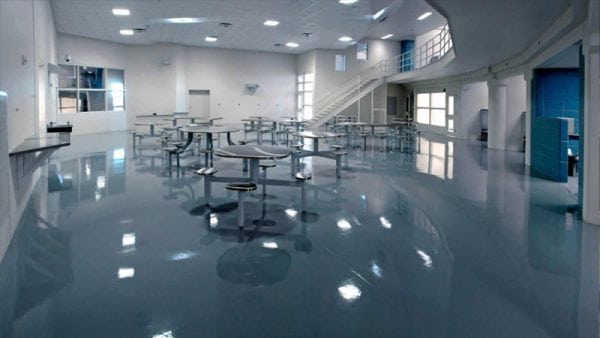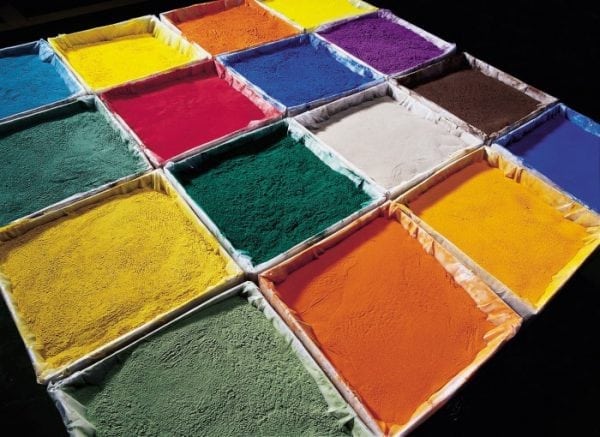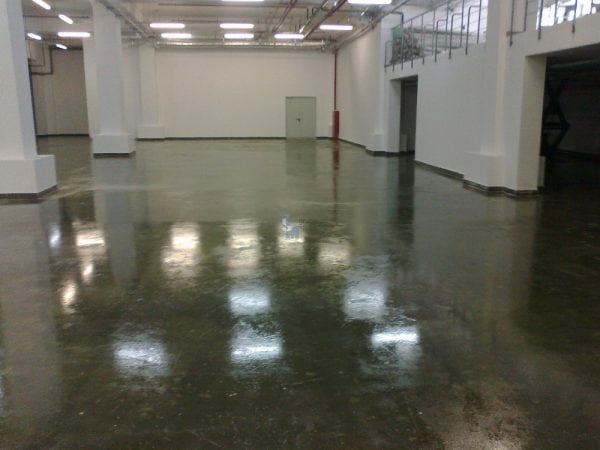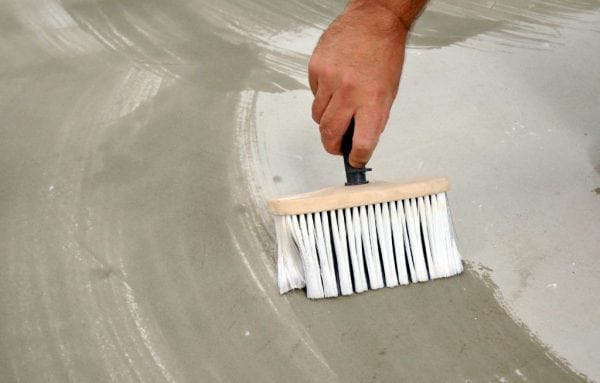Epoxy paint is one of the most resistant types of coatings. Its main component is epoxy resins. Such paint perfectly tolerates loads and friction, and therefore has found application in a variety of conditions. It can cover any surface - metal, plastic, wood, glass, concrete.
- Varieties of compositions based on epoxy and their properties
- Composition
- Scope of application
- Work rules
- Compositions for concrete
- Preparatory work
- Coloring instruction
- Manufacturers
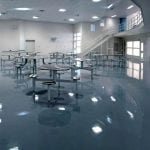
Varieties of compositions based on epoxy and their properties
Epoxy paints are two-component - resin and hardener, powder, aerosol (used mainly for painting car parts). For domestic use, mainly compositions based on cold cured epoxy are used. Such paints harden after a day or more without additional exposure to the surface.
High-strength coatings are required at the factory, and they can only be obtained from hot-cured epoxy. Hot cured resin is used in epoxy powder paints, and cold in two-component and aerosol paints.
Important! The difference between the compounds is significant. During hot curing (polymerization), the network of paint molecules is denser and stronger, while cold (network) it is less frequent and has not such strong molecular bonds.
The general properties of epoxy paints distinguish them from other coatings:
- create a solid surface.
- Suitable for painting on floors and walls.
- waterproof, therefore they can be used as waterproofing in bathrooms and forpool staining.
- resistant to mechanical stress.
- Resist various harsh chemicals.
- They have excellent adhesion to concrete, plastic and metal surfaces.
- Suitable for flooring in residential and industrial premises.
- A rich color palette and many textures allow you to embody interesting design ideas.
Spray paints are most often acrylic epoxy. They are characterized by high anticorrosion properties, resistance to various chemical influences, including aggressive ones (suitable for outdoor use), and a high degree of self-cleaning (dust and dirt do not stick to the painted surface). Aerosol acrylic epoxy formulations form a durable, glossy, scratch and chip resistant coating.
There are several varieties of epoxy powder paints that differ from each other in their technical characteristics:
- Standard. The polymerization process takes place in a chamber at a temperature of + 220 ° C in the first 10 minutes of processing.
- Low temperature. The polymerization process takes place in a chamber at a temperature of + 180 ° C in the first 20 minutes.
- Polyester. They have high wear resistance, a rich palette of colors, textures (metallic, antique, transparent varnish), gloss levels, low toxicity. They are used for maximum surface protection against friction, often replacing the primer.
- Epoxy polyester. Such paints are inexpensive, have medium abrasion resistance, are resistant to sunlight (do not turn yellow), high temperatures, scratching and other mechanical influences, are afraid of aggressive chemical solvents and rust. At the same time they are decorative - they are used as film coatings for precious metals and perfume bottles.
Composition
Epoxy paints consist of diane oligomers (molecular weight 1400 - 2500), modifiers, hardener, fillers and pigments, additional substances - hardening accelerators, viscosity and spreading regulators.
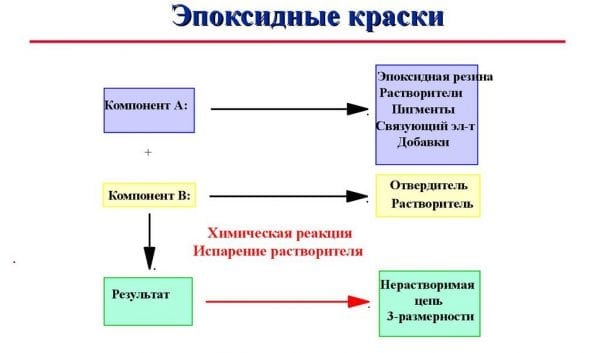
Two-component compositions for manual self-coloring of metal parts approximately 40% consist of fillers: spreading regulators, modifiers, and pigments. Epoxy powder coatings (heat-insulating) - they are called compounds and are always applied only in a thick layer - almost never contain modifiers and contain up to 70% of fillers with a low coefficient of thermal expansion. Usually it is quartz, represented by dust, or fiberglass.
to contents ↑Scope of application
Epoxypolyester, acrylic epoxy and epoxy paints are widely used in various fields. They form different types of surfaces - completely non-slip, protective, fluorescent, matte, glossy, textured, quick-drying.
These formulations are stained with:
- travel supplies;
- household items;
- internal and external parts of cars;
- electrical appliances;
- decorative garden figures;
- office furniture;
- radiators, heaters;
- Toys
- floors and walls;
- facades;
- tanks with chemicals.
Epoxy paint can be used to paint concrete floors in the bathroom. This will protect them from moisture, and neighbors from the bottom from leaks. It is also a great alternative to ceramic tiles. This paintwork material can be used for corrosion protection of coils and other metal parts in bathrooms and in kitchens. If the tree is coated with such paint, it will be reliably protected from decay and insects.
to contents ↑Work rules
Epoxy resin is a synthetic polymer. When combined with a hardener, a thermochemical reaction occurs with the release of a large amount of heat. Therefore, you need to work with two-component epoxy paints carefully, always observing the safety rules:
- Use protective clothing when preparing and applying paint - gloves, a jumpsuit and a respirator are required. It’s nice to have glasses.
- Use special sticks to put together the compound. Never use food supplies.
- If the paint does get on your skin, immediately remove it with denatured alcohol or wash it off with warm water and soap. If the composition hardens, removing it will be problematic.
- Provide ventilation - open the window in the room where the staining is carried out.
- Store cans of paint and hardener at a temperature not exceeding 40 ° C, away from sources of heat and sunlight.
to contents ↑Important! Before painting, it is necessary to carry out a set of works to remove the old coating, cleaning and degreasing the surface. In the presence of obvious chips and potholes, they must be repaired.
Compositions for concrete
Epoxy paint for concrete floors is a qualitatively new type of paints and varnishes. If classic epoxy resins are never mixed with water, as they become turbid and lose some of their properties, then in the case of concrete paint not ordinary water is added, but distilled water, resulting in an epoxy dispersion.
A striking representative of this type of paintwork is Epostone - water-based epoxy primer-enamel for concrete floors. Among its technical characteristics, it is worth highlighting the following:
- excellent adhesion to concrete;
- high wear resistance;
- resistance to non-concentrated chemicals;
- ecological cleanliness;
- resistance to atmospheric phenomena (use outdoors is allowed).
The most important positive quality of such enamel is the ability to use on raw concrete.In addition to saving time, the technical characteristics of the coating itself are improved. Epoxy resin prevents the evaporation of moisture from its surface. After gaining working strength, dusting of the surface is completely excluded.
to contents ↑Preparatory work
There are two possible applications for epoxy primer-enamel on concrete - on fresh concrete screed and on an old slab. Preparation processes vary.
In the first case, staining is possible already 5 days after pouring. At this moment, the humidity of the concrete is high enough, so the epoxy deep penetrates into its pores, giving additional surface strength. Leveling the floor in this case is not required, but you will have to go over it with a "helicopter" - a grinding machine to remove the cement milk and open the pores. If there is no helicopter, then the treatment must be carried out with a stiff brush. Then vacuum the surface thoroughly.
If old concrete is to be stained, it is necessary to thoroughly prepare it - close up all the potholes (with epoxy putty) and remove, if any, the humps. Then vacuum the surface. The humidity of the old concrete coating should not exceed 4%. Otherwise, the epoxy paint will begin to peel off pretty soon.
to contents ↑Important! Potholes and cracks are necessarily stitched, then priming is carried out and only after that puttying. The primer is prepared from primer-enamel, which will be stained - it is diluted with 10% distilled water. After applying the primer, it is necessary to wait from 12 hours to a day for it to dry out.
Coloring instruction
The technology for applying epoxy primer-enamel to concrete is quite simple, but you must follow the instructions so as not to spoil the material:
- Thoroughly mix component A - epoxy with pigment and additives.
- Measure out the required amount of component A and mix it with component B (hardener). The ratio of parts is 100: 17. Mixing time - not more than 3 and not less than 2 minutes. Let the mixture stand for about a quarter hour before starting work.
- Make a stain.
to contents ↑Important! The shelf life of the finished paint is about 4 hours. Therefore, all work must be carried out quickly. The temperature of the substrate should not be lower than + 15 ° C. The surface can be operated in the range of -15 - + 60 ° С.
Manufacturers
In practical applications, epoxy primer-enamel for the concrete floor of the Russian manufacturer Epostone has proven itself best. Excellent reviews about the paint "Elacor-ED" is also a Russian brand. In both samples there are no inert fillers, the presence of which reduces the cost of the material, but at the same time reduces its properties.
Excellent quality in epoxy paints manufacturers from the United States. They are the most environmentally friendly and safe. Their cost is slightly higher, but the quality is worth it. Among the most famous American manufacturers it is worth highlighting:
- Aervoe
- Ktisis;
- Rocol;
- ITW Spraytec;
- Huntsman Advansed Materials.
The choice of epoxy paints in the construction market is great. It is quite difficult to choose the material of the right quality and suitable for the price. Therefore, before buying, analyze for what purpose you need such paintwork, evaluate your financial capabilities and only after that go to the construction market. And never buy epoxy in a market where it is impossible to keep the right storage conditions.

